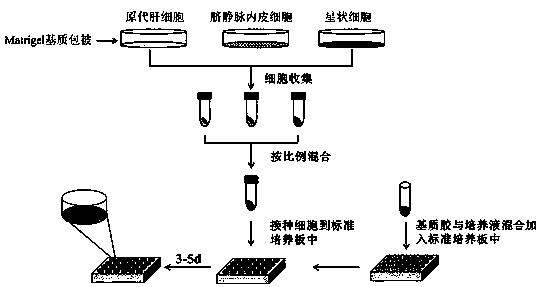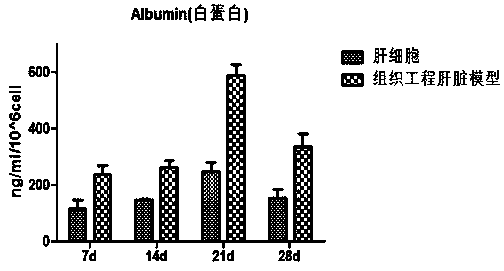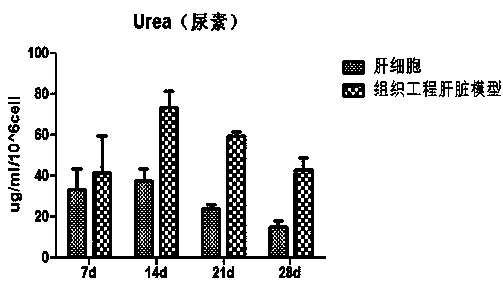Preparation method of tissue-engineered hepatic model
A technology of tissue engineering and modeling, applied in biochemical equipment and methods, tissue culture, liver cells, etc., can solve the problems of maintaining liver structure and function, and achieve long-term drug exposure, high mitochondrial function, and increased expression levels.
- Summary
- Abstract
- Description
- Claims
- Application Information
AI Technical Summary
Problems solved by technology
Method used
Image
Examples
Embodiment 1
[0030] In order to overcome the inability of the existing liver model to maintain the structure and function of the liver for a long time in vitro, thereby performing functional tests such as drug metabolism and toxicity evaluation; the present invention provides a method such as figure 1 The preparation method of the tissue engineering liver model shown includes the following steps:
[0031] Step 1: Carry out the cultivation and expansion of seed cells;
[0032] Step 2: Prepare the liquid and matrix for model construction;
[0033] Step 3: Perform cell collection;
[0034] Step 4: Carry out model construction.
[0035] The first step: seed cell culture and expansion, including the following steps:
[0036] Step 1. Preparation of Matrigel: After freezing and thawing the Matrigel matrix overnight on ice at 4~8℃, use a pre-cooled pipette tip to mix the Matrigel matrix into a homogenate shape; use pre-cooled pure DMEM (according to 1:3 ~30 Dilute the Matrigel matrix; coat the diluted Matri...
Embodiment 2
[0047] Matrigel preparation: After freezing and thawing the Matrigel matrix overnight in a refrigerator at 4°C, mix it with a pre-cooled pipette tip to form a homogenate. Take a 50ml pre-cooled EP tube, add 28ml of pre-cooled pure DMEM medium (without serum, no additives and no antibiotics), add 2ml Matrigel matrix to dilute, all operations need to be performed on ice. Take out the culture vessel that needs to be coated, place it on ice, and coat the diluted Matrigel matrix in the desired culture vessel with the coating amount covering at least the entire growth surface of the vessel. Incubate for 1 hour at room temperature. Remove the unbound Matrigel matrix and rinse gently with pure DMEM medium.
[0048] Extraction and culture of primary hepatocytes: Weigh a certain amount of liver tissue, mechanically cut it, and digest it with 0.1% collagenase at 37°C for 30 minutes, and then digest with 0.125% pancreatin at 37°C for 30 minutes, 40 mesh Filter through a sieve to make a sin...
Embodiment 3
[0064] Matrigel preparation: After freezing and thawing the Matrigel matrix overnight in a refrigerator at 4°C, mix it with a pre-cooled pipette tip to form a homogenate. Take a 50ml pre-cooled EP tube, add 29ml of pre-cooled pure DMEM medium (without serum, no additives and no antibiotics), add 1ml Matrigel matrix to dilute, all operations need to be performed on ice. Take out the vessel to be coated, place it on ice, and coat the diluted Matrigel matrix in the required culture vessel, with the coating amount covering at least the entire growth surface of the vessel. Incubate for 1 hour at room temperature. Remove the unbound Matrigel matrix and rinse gently with pure DMEM medium.
[0065] Extraction and culture of primary hepatocytes: Weigh a certain amount of liver tissue, mechanically cut it, and digest it with 0.1% collagenase at 37°C for 30 minutes, and then digest with 0.125% pancreatin at 37°C for 30 minutes, 40 mesh Filter through a sieve to make a single cell suspensi...
PUM
 Login to View More
Login to View More Abstract
Description
Claims
Application Information
 Login to View More
Login to View More - R&D
- Intellectual Property
- Life Sciences
- Materials
- Tech Scout
- Unparalleled Data Quality
- Higher Quality Content
- 60% Fewer Hallucinations
Browse by: Latest US Patents, China's latest patents, Technical Efficacy Thesaurus, Application Domain, Technology Topic, Popular Technical Reports.
© 2025 PatSnap. All rights reserved.Legal|Privacy policy|Modern Slavery Act Transparency Statement|Sitemap|About US| Contact US: help@patsnap.com



